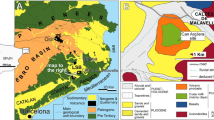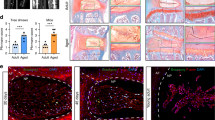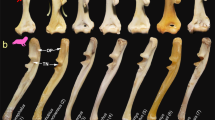Abstract
There have been no definite reports of fossil tree shrews although a rib cage from the Tatrot Formation of India has been identified as Tupaia1, and fossil material, including the anterior part of a skull (YGSP 8089) with broken crowns of teeth (I1–P4) and a lower left molar (YGSP 8090), from the Middle Śivaliks of Pakistan, has been assigned to the sub-family Tupaiinae (unpublished results by I. Jacobs). The lack of material makes it difficult to assess the evolutionary position of this group, which, together with moles and hedgehogs, is considered to include the most direct modern descendents of the primitive placentals2. The living tree shrews have also attracted great interest because of the suggestion that they are related to primates. We report here a maxillary fragment (PUA I5) of the left side with M1–M3 and an isolated right lower molar, probably M2, (PUA I6) recovered from the middle Śivalik deposits of Haritalyangar in Himachal Pradesh, India. We have referred this to the Tupaiinae, although we cannot assign generic and specific names. The following communication3 describes more substantial material discovered later.
This is a preview of subscription content, access via your institution
Access options
Subscribe to this journal
Receive 51 print issues and online access
$199.00 per year
only $3.90 per issue
Buy this article
- Purchase on SpringerLink
- Instant access to full article PDF
Prices may be subject to local taxes which are calculated during checkout
Similar content being viewed by others
References
Dutta, A. K. India Minen. 29, 76 (1975).
Romar, A. S. Vertebrate Paleontology (University of Chicago Press, 1966).
Chopva, S. R. K. & Vasishat, R. N. Nature 281, 214–215 (1979).
Clark, W. E., Le Gros . The Antecedents of Man (Edinburgh University Press, 1959).
Gromova, V. I. (ed.). Fundamentals of Paleontology, 13 (Israel Program of Scientific Translations, Jerusalem, 1968).
Lyon, M. W. Proc. U.S. natn. Mus. 45, 1 (1913).
Steele, D. G. Symp. Fourth Int. Cong. Primat. 3, 154 (1973).
Swindler, D. R. Dentition of Living Primates (Academic, London, 1976).
Author information
Authors and Affiliations
Rights and permissions
About this article
Cite this article
Chopra, S., Kaul, S. & Vasishat, R. Miocene tree shrews from the Indian Śivaliks. Nature 281, 213–214 (1979). https://doi.org/10.1038/281213a0
Published:
Issue date:
DOI: https://doi.org/10.1038/281213a0
This article is cited by
-
Tupaiine tree shrews (Scandentia, Mammalia) from the Yuanmou Lufengpithecus locality of Yunnan, China
Swiss Journal of Palaeontology (2012)
-
Discovery of cretaceous arboreal eutherians
Naturwissenschaften (1994)
-
Well-groomed predecessors
Nature (1981)
-
Proposed fossil tree shrew genus Palaeotupaia
Nature (1980)



